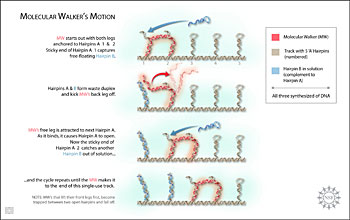All Images
News Release 08-008
Molecular Walker Takes Baby Steps
Locomotion of two-legged DNA walker holds promise for molecular machines
This material is available primarily for archival purposes. Telephone numbers or other contact information may be out of date; please see current contact information at media contacts.

Researchers have synthesized a molecular structure designed from single and double-stranded pieces of DNA that responds to a similarly modeled track, by walking down it autonomously. The walker places foot-over-foot as each appendage is attracted biochemically to the next hairpin along the track. As foot and hairpin make contact, the hairpin unravels. The free end of the hairpin then catches a complementary hairpin that is free-floating in the solution that the whole system is immersed in. Both hairpins coil together forming a "waste duplex" (or the familiarly shaped double helix), releasing the walker's foot for its next stride. If the walker reaches the end of the track successfully, it leaves behind non-reusable material, and the track is spent. Its travels are more perilous than may seem if it lifts the wrong foot and finds itself trapped between two open hairpins, the walker will fall off never seeing the end of its track.
Credit: Zina Deretsky, National Science Foundation after figure by Peng Yin, Harry M. T. Choi, Colby R. Calvert and Niles A. Pierce, California Institute of Technology
Download the high-resolution JPG version of the image. (510 KB)
Use your mouse to right-click (Mac users may need to Ctrl-click) the link above and choose the option that will save the file or target to your computer.


